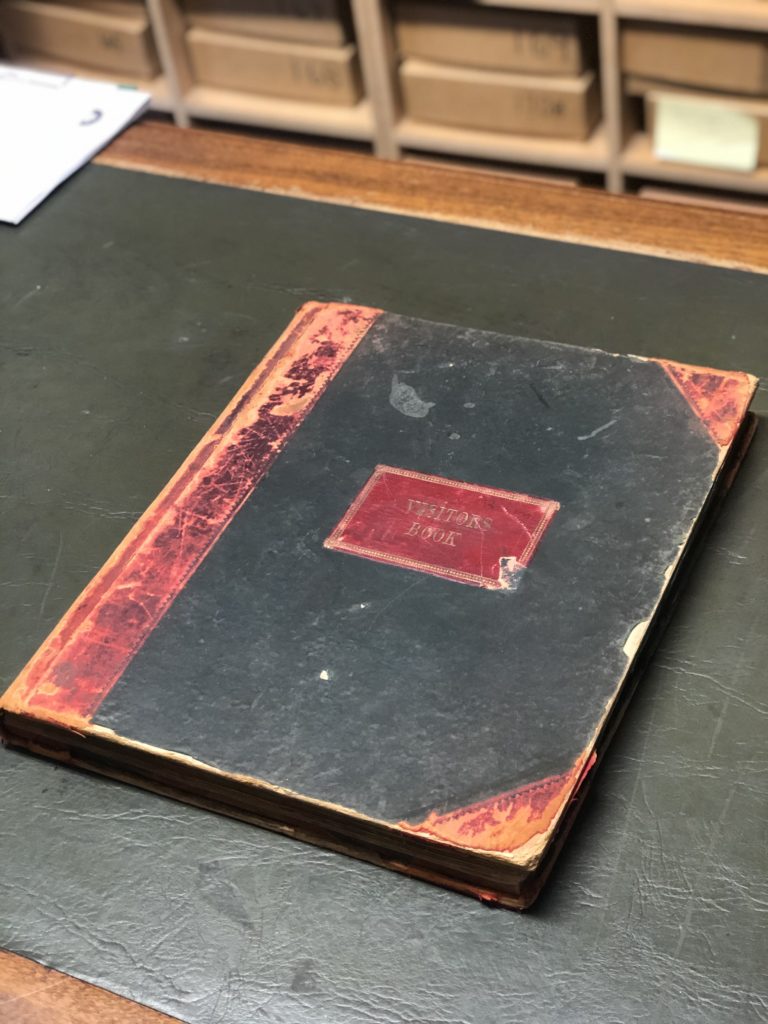Ever wondered what a typical day for our volunteers looks like and what stories lie hidden in our collection? Well wonder no more! One of our volunteers, Lisa, has put together a great rundown of how starting one task turns into a deep dive into the archives. Here is the story (and side stories) from the mysterious record marked “Box02″…
The what end of Collins Street?
Visitors’ Book – Oriental Hotel (1913-20)/ RHSV (1950-71)
MS-000527
Among the cardboard boxes, held on dusty shelves in the Royal Historical Society of Victoria’s (RHSV) manuscript storage room, lies a box indistinctly marked “Box02”. Opening the box, one must fight the mighty silverfish who have sustained themselves grazing on the delicious leather coverings of the two books held within. Yet, upon banishing the fearsome creatures, one will find that her efforts are well rewarded as new histories are brought to light, perhaps having been banished to the darkness for close to a century.

The first book encountered, is quite unremarkable: a ledger of the Melbourne Fire and Marine Insurance Company and its monthly financial dealings. Yet, the second, simply inscribed “Visitors Book”, unlocks stories long forgotten in the history of Melbourne.
The red-and-navy-bound book once belonged to the prestigious Oriental Hotel, 41-53 Collins St, Melbourne. Within its pages, one finds the signatures, addresses and comments of hotel visitors from 1913 through to 1920.


Built in 1878, the Oriental Hotel quickly became a popular destination for Melbourne’s more discerning visitor. It was particularly well-known for its fine dining. In 1910, it was purchased by wealthy Victorian businessman, Pearson Tewksbury, allegedly after he was asked to leave by the manager. He took no time in extending the hotel by the building of a new wing and the creation of a private fleet of cars that eventually became Melbourne’s first taxi company. Despite council permission to expand the hotel, he was outright denied permission to create a European-style outdoor dining space as it was believed that it would interrupt the flow of the footpath. It was not until the 1950s when the hotel was purchased by Leon Ress, that this addition was allowed. The outdoor café became the first of its kind and gave birth to the moniker, “the Paris-end of Collins Street”.
Given the importance of the hotel, one can imagine the glamorous stories of those who stayed there. Perusing the visitors’ book pages, one entry from early 1914 catches the eye. Next to a large list of names is written: “New York Giants, Chicago White Sox, Baseball World Tour”.

In 1913, John “Mugsy” McGraw, manager of the New York Giants, and Charles Cominsky, owner of the Chicago White Sox, concocted a brilliant plan that would make them as famous as Albert Spalding (baseball manager and founder of the sporting company bearing his name). They decided that they would send their teams on a world tour which would begin immediately after the 1913 World Series of Baseball and visit 11 countries, Australia included. When the teams arrived in Melbourne on the 6th January 1914, they were greeted by fans at Spencer Street Station (now Southern Cross) and, later treated to a reception at Government House. The teams played two games, the first of which was held at the Melbourne Cricket Ground, 4pm on 7 January, to some 7,500 spectators. To mark the importance of the game, the Governor-General, Lord Denman, pitched the first ball. The Age reports that
His Excellency’s delivery was what cricketers call “a bit short,” but it was treated with great respect by the visitors, who subsequently presented the ball to Lord Denman as a memento of the occasion.
By all accounts, the American baseballers enjoyed their time in Australia as much as the Australians enjoyed their company. In the visitors’ book, reads the comment, “Our one regret in leaving the Oriental and Melbourne is that we have to leave the charming ladies in charge of the office.”

Another, less grand, story found within the pages of the visitors’ book is that of Captain Arthur Seaforth Blackburn. Born in Woodville, South Australia in 1898, Blackburn enlisted in the Australian Imperial Forces (AIF) at the outbreak of the First World War. He was one of the lucky ones who survived the Gallipoli Campaign and while fighting on the Western Front in 1916, he was recommended the Victoria Cross (VC) for bravery after almost single-handedly storming an enemy trench while members of his troop were dying around him. He became the first recipient of the VC from South Australia. Blackburn was discharged in 1917 due to injury and returned home to Adelaide where he married Ada Rose Kelly on 22 March 1917. Entered in the visitors’ book, in what one assumes to be Blackburn’s own hand, is the name “Capt. & Mrs A.S. Blackburn” and address “72 King William St, Adelaide”. The entry is undated but given then dates in the entries around this one, it appears that the couple arrived at the Oriental to enjoy their honeymoon.

These are just some of the stories to be discovered within the RHSV’s collection.

 239 A'Beckett Street Melbourne, Victoria, 3000
239 A'Beckett Street Melbourne, Victoria, 3000  03 9326 9288
03 9326 9288  office@historyvictoria.org.au
office@historyvictoria.org.au  Office & Library: Weekdays 9am-5pm
Office & Library: Weekdays 9am-5pm

